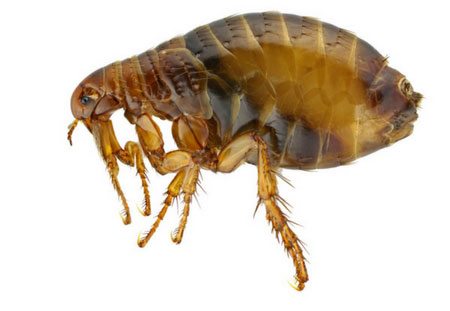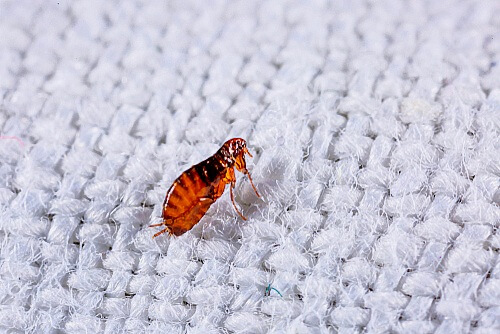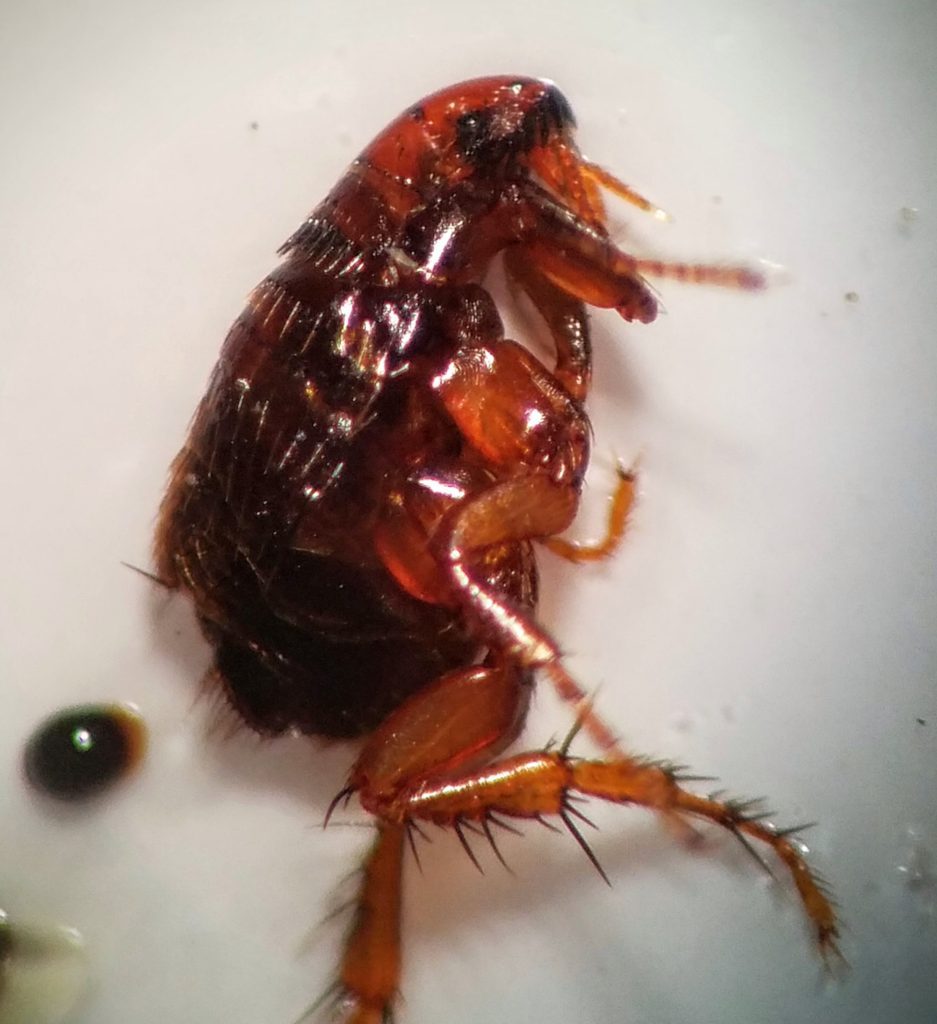Flea Control
Flea Control in Cleveland, OH
While flea infestations are common, finding and treating the source of the problem is often vey complex. Chronic flea issues occur when fleas latch onto you and your pets — that part is easy enough to understand. The problem, however, is misinformation about pet flea treatments. Most pet owners rely on their pets’ monthly flea treatments to prevent fleas. However, these flea treatments don’t attack all possible angles of infestation. New fleas that developed away from the pet simply jump onboard, which causes the issue to reoccur. In other words, as long as there’s a separate source of fleas other than your pet (rodents, for example, are a big source of fleas), you will always face the risk of re-infestation. In order to effectively manage an infestation, fleas must be removed from the pets, the yard, and the home. Removing and excluding flea-ridden wildlife from your property is also an important factor to consider.

Cat Flea
In Ohio, the Cat Flea, Ctenocephalides felis, is our primary pest species. Cat fleas are unique due to the fact that the adult remains on their host, rather than hopping off after a feed. Their laterally-compressed bodies are adapted to weave in and out of fur. Cat fleas are also highly adapted in several other ways, and can survive repetitive scratching and other grooming actions. They have numerous hairs and spiked protrusions that can latch onto fur and clothing. A scaly exoskeleton shell protects them from injury. They also have a great resistance to being squished. Want proof? If you manage to find and catch a flea, squeeze it as hard as you can between your fingers. Then watch it jump away. They are powerful jumpers and can propel their bodies to a height of around 7 inches. In fact, they can reach their host from slightly over 12 inches away. Common hosts in urban areas include cats, dogs, rats, mice, squirrels, chipmunks, raccoons, opossums, skunks, rabbits, birds, and even humans.
Life Cycle
Fleas go through a life cycle similar to that of a butterfly. Their complete metamorphosis includes egg, larvae, pupae and adult life stages. The entire cycle can take 30-75 days to complete, and the process speeds up in hot and humid weather. As a result, flea season in Cleveland, OH runs from July through October.
Adult cat fleas live for 4-25 days. In order to lay eggs, a blood meal is required. When a female flea is properly fed, eggs can be laid at a rate of up to 1 egg per hour. The female loosely adheres her eggs to their host. The eggs will then fall off where the host animal sits and rests. Within 2 weeks, the eggs hatch into tiny worm-like larvae. They feed on skin flakes and dried blood during a development period that can last up to several months. These larvae thrive in hot and humid areas that are protected from rain and sunlight.
In order to mature into adults, the larvae require their own blood meal. In order to provide this, the adult feeds on more blood than they personally require. The adult then excretes this undigested blood — this is what’s known as flea dirt. As the flea dirt dries, the fecal matter falls from the host. The larvae will feed on the flea dirt until they’re mature enough to spin a protective cocoon in which to pupate. Carpet fibers, dust, hair, and other debris adhere to the silk of the cocoon. This adds camouflage and an additional protective layer to the pupal case. Because newly-emerged adults require a blood meal within a week in order to survive, they will wait to pick up a signal that a host is nearby before breaking out of their cocoons.

Fleas in Ohio: Facts & Information
Fleas in Ohio - Information and Facts Fleas in Cleveland, Ohio Pet Owners spend over 1 billion dollars a year controlling fleas. This makes fleas an important pest that effects dogs and cats. Fleas are small, narrow bodied, external parasites. They feed off of a host mostly at night or while it rests. Flea bites on humans usually occur near the ankles, with multiple bites lined in a row. There are several species of fleas. In Cleveland, Ohio the cat flea is the only flea to impact our lives. Nearly every dog with fleas in Cleveland has the cat [...]
Tips and Tricks
- Try restricting pets’ access into infested areas outdoors.
- In addition, humans can wear repellents to prevent fleas from grabbing hold when visiting areas with high flea populations.
- Before bringing pets indoors, use flea combs to remove any fleas. Flea combs can remove 10% – 60% of fleas on a host animal.
- By regularly washing or disposing of pet bedding, you can disrupt the flea life cycle.
- In addition to laundering bedding, make an effort to vacuum up eggs and flea dirt where ever pets stop or rest. This must occur every other day to be effective.
- Bathing pets removes the flea dirt and dander that provides food for flea larvae.
- Gather adults with light traps as they emerge from their cocoons.
- Cut the lawn and remove weeds to reduce harborage outdoors.
- Clean and sweep porches, patios and decks.
- Screen vents and chimneys to exclude potentially flea-infested wildlife from nesting inside your home.
- Finally, use air conditioning inside the living space and dehumidifiers in basements to create an unfavorable indoor environment for fleas.
Get A Flea Control Price Quote Emailed To You
Request a free no obligation consultation to discuss your needs.
2-Visit Flea Control Plan
- Receive a 60-day warranty when preparation guidelines are completed
- Add 2 lawn treatments for an additional $100 plus tax
If preparation guidelines are not met, or sanitation recommendations are not followed, there will be a 100$ fee for any retreatments beyond the second within the 60-day warranty period.
Flea Treatment Preparation
Download Our Complete Flea Treatment Customer Preparation Checklist
To help maximize your treatment’s effectiveness, we’ve provided a flea treatment preparation checklist:
- Clear all carpeted floors including closets (if possible) of boxes, clothing and any other items that will prevent a thorough and effective treatment.
- Wash (in hot water) or destroy all pet bedding.
- Mop wood, tile, and vinyl floors.
- Vacuum and mop the basement floor.
- Vacuum all carpeting and rugs thoroughly.
- Carefully vacuum pet resting areas including under furniture and draperies.
- Window sills and appliance tops should to be cleaned if you have cats that rest on them.
- Vacuum furniture especially between and under cushions.
- Empty the contents of the vacuum cleaner into a plastic trash bag and dispose of immediately.
- Remove pets from the home (prior to application).
- Store or cover all pet food containers and bowls.
- Cover fish bowls or fish tanks with a damp towel.
- Arrange to have dogs, cats and other flea infested pets professionally treated by your veterinarian or groomer during the time of service.
- Be prepared to vacate the dwelling during service and for about 4 hours following service. This will give the necessary time for the products to dry.
After the treatment, please continue to vacuum all carpeted surfaces daily for 7 days after the service. It is also beneficial to wax hardwood floors a few days following the final treatment.
Quick Links
Get In Touch
Lakewood Exterminating, 13443 Detroit Ave., #8, Lakewood, OH 44107
Lakewood Exterminating, 13443 Detroit Ave., #8, Lakewood, OH 44107



